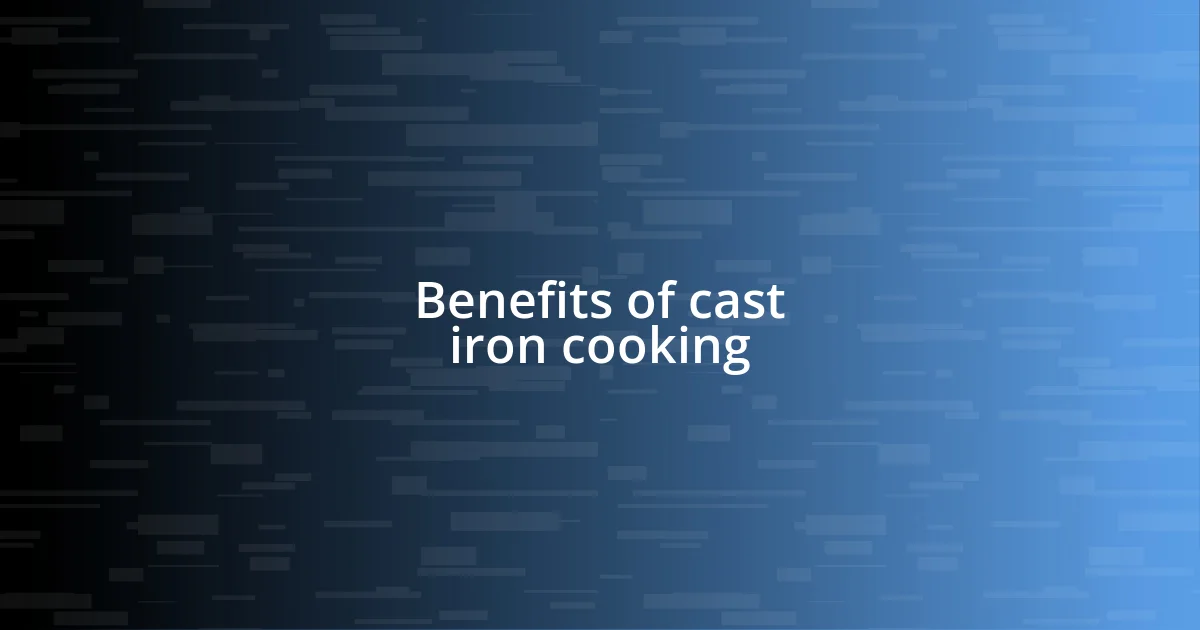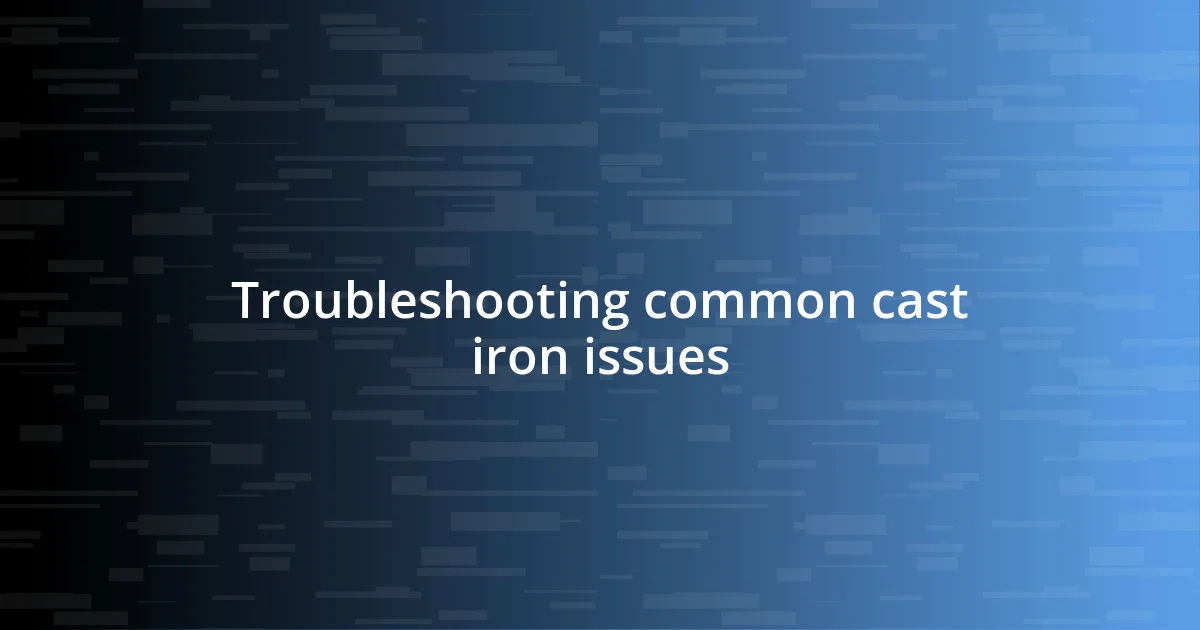Key takeaways:
- Cast iron cookware excels in heat retention, versatility, and enhances the nutritional value of meals by leaching iron.
- Choosing the right cast iron includes considering size, finish, and weight for manageable and effective cooking experiences.
- Proper seasoning and gentle cleaning are essential for maintaining cast iron, while troubleshooting common issues like stuck food and uneven heating requires patience and technique.

Benefits of cast iron cooking
One of the most notable benefits of cooking with cast iron is its incredible heat retention. I remember the first time I made cornbread in my grandmother’s cast iron skillet; the golden crust came out perfectly crispy. Have you ever experienced a dish that seems to hug the flavors together in such a comforting embrace? That’s the magic of cast iron for you.
Another remarkable advantage is the versatility of cast iron cookware. I often toss my skillet in the oven after searing meat on the stovetop, which saves me time and dishes. It’s almost like a trusty sidekick in my cooking adventures! Doesn’t it feel satisfying when one piece of cookware can handle so many cooking techniques?
Let’s not forget that cooking with cast iron can enhance the nutritional value of your meals. This may sound surprising, but it can actually leach small amounts of iron into your food, which is beneficial, especially for those who need a boost in their iron intake. I’ve found it comforting to know that every meal I cook in my cast iron skillet is not only delicious but also contributes to my health. How can you argue against a piece of cookware that nourishes both the palate and the body?

Selecting the right cast iron cookware
When it comes to selecting the right cast iron cookware, I’d recommend considering the size and shape that best fits your cooking style. For instance, a 10-inch skillet is often my go-to for everyday meals, while a larger Dutch oven shines during family gatherings. I remember a time I bought a massive 12-quart pot, thinking it would be perfect for stews, but I found it cumbersome. Have you ever felt overwhelmed by a piece of cookware that looked impressive but was impractical?
Another key aspect to keep in mind is the finish of the cast iron. Some cookware comes pre-seasoned, while others require a little love and attention to develop a natural non-stick surface. Personally, I enjoyed the ritual of seasoning my first skillet; it felt like creating a canvas ready for culinary masterpieces. It’s fascinating how a little oil and heat can transform raw iron into a durable cooking ally. Do you enjoy the idea of nurturing your cookware as much as you enjoy cooking?
Lastly, don’t forget to assess the weight of the cast iron pieces. Heavier pans can provide more even heating, but they can also strain your wrist if you frequently lift and maneuver them. I once had to reorganize my kitchen after realizing the weight of my larger Dutch oven became a barrier rather than a boon during meal prep. Isn’t it amazing how something as seemingly simple as weight can change our cooking experience?
| Factor | Considerations |
|---|---|
| Size | Choose based on your cooking needs; a smaller skillet for everyday use and larger pots for bigger meals. |
| Finish | Pre-seasoned cookware saves time, while raw cast iron allows for personal seasoning preference. |
| Weight | Heavier pans offer better heat distribution, but consider ease of handling in your kitchen. |

Proper seasoning techniques for cast iron
I’ve learned that proper seasoning is crucial for maintaining the non-stick surface and longevity of cast iron cookware. My own experience taught me that seasoning isn’t just a chore; it’s like bonding with my skillet. The smell of oil heating up and the sight of the pan darkening with each application remind me of those moments spent in the kitchen with my mother. It’s almost meditative. While each person may have their preferred technique, a few key steps stand out.
- Clean Thoroughly: Start with a clean skillet, removing any rust or old seasoning with a mild abrasive if needed.
- Choose Your Fat: Opt for oils with high smoke points, like grapeseed, canola, or flaxseed oil. I often use flaxseed oil because it provides a nice, hard finish.
- Apply Evenly: Use a paper towel to coat the skillet lightly, ensuring not to leave excess oil. Too much can lead to a sticky surface.
- Bake It On: Place the skillet upside down in the oven at a high temperature (around 450°F) for about an hour. I remember the first time I did this; I was amazed at how the heat transformed the skillet into a smooth, glossy surface.
- Cool It Down: Let it cool in the oven to avoid thermal shock. After my first seasoning session, I learned that patience pays off!
With these techniques, you’ll not only create a non-stick surface but also build a connection with your cookware. It’s fascinating how caring for a skillet can evoke such a sense of pride, much like nurturing a thriving plant in your home. My skillet still holds memories of family gatherings and comforting meals, which makes every bit of effort worthwhile.

Best practices for cooking with cast iron
I’ve found that preheating your cast iron skillet is one of the simplest and most effective tricks to ensure perfectly cooked food. When I first started using cast iron, I would often toss my ingredients in while the skillet was still cold. Do you know what happened? I often ended up with unevenly cooked meals and a lot of frustration. Now, I give my skillet a few minutes to heat up before adding anything, and it makes all the difference, achieving that lovely sear on meats and veggies. There’s something satisfying about hearing that sizzle, isn’t there?
Maintaining the seasoning is essential, and I’ve learned to be cautious when cleaning my cast iron. I used to scrub mine with harsh sponges and soap, thinking it was the best way to keep it clean. Instead, I’ve shifted to simply using hot water and a soft sponge. On occasion, I’ll sprinkle a little coarse salt and use it to scrub stubborn bits. It’s like giving my skillet a gentle exfoliation! Have you ever felt like your cookware deserves some TLC? Well, treating it kindly can ensure that it keeps performing beautifully for years to come.
When you’re cooking with cast iron, timing and temperature adjustments are also important. Iremind myself to lower the heat slightly compared to what I might use with other pans. I once made the mistake of cooking a delicate fish fillet over high heat, and let’s just say it didn’t turn out well. Now, I pay attention to how cast iron retains heat and adjust accordingly. It’s fascinating how a minor tweak in cooking style can lead to so much better results, don’t you think?

Cleaning and maintaining cast iron
Cleaning and maintaining cast iron might seem daunting at first, but it has become one of my favorite rituals. After using my skillet for a tasty cornbread, I’ll often find tiny bits stuck to the bottom. Instead of reaching for soap, which can strip away the seasoning, I simply run it under hot water and scrub gently with a soft sponge. It’s almost like a quick spa day for my skillet, preserving its charm while removing any remnants of my culinary adventures.
If you’ve ever found yourself wondering how to tackle rust, I’ve been there too. During one summer, I left my forgotten skillet out in the garage, and it needed some serious love. I applied a mixture of coarse salt and oil, turning it into a paste to tackle those rusty spots. It felt like rescuing an old friend. After a thorough rinse and re-seasoning, my skillet came back to life, just reminding me how resilient and rewarding caring for cast iron can be.
As I keep my skillet in tip-top shape, I always remember to store it properly. A thin layer of oil helps prevent any moisture from wreaking havoc. Whenever I’ve neglected this step, I’ve faced the heartbreak of rust creeping in again. So, I now make it a point to give it a quick wipe down before tucking it away. Isn’t it wonderful how a small act like this can prolong the life of such a trusty kitchen companion?

Troubleshooting common cast iron issues
When it comes to troubleshooting issues with cast iron, one problem that many of us face is stuck food. I remember one time when I tried to flip a frittata in my skillet, only to have half of it cling stubbornly to the surface. It was disheartening, and I felt like I had failed. The key here is patience. Sometimes, just letting the food sit for a little longer allows the natural release process to happen. If I had only waited a few minutes, my frittata would have slid out effortlessly instead of turning into a scrambled mess.
Another common issue I’ve encountered is uneven heating. I once made the mistake of preheating my skillet on high heat and then throwing in some beautiful steaks. The end result? One side was perfectly seared, while the other was barely warmed through. What I learned is that cast iron distributes heat differently than other pans. Now, I start with medium heat and let my skillet warm up gradually. It’s like giving the cast iron a moment to breathe before it goes to work.
And then there’s the fear of scratches when using metal utensils. I’ve had my worries too! The first time I used a metal spatula, I cringed at the thought of damaging my skillet. But after some research and experimentation, I discovered that a well-seasoned cast iron skillet can withstand a bit of metal. I’ve successfully navigated this issue by choosing high-quality utensils that won’t compromise the surface. It’s reassuring to know that I can enjoy my cooking tools without constantly worrying about leaving a mark. Have you ever felt that same mix of fear and excitement in the kitchen? It’s part of the journey!

Recipes perfect for cast iron cookware
When I think about recipes that shine in cast iron, my mind immediately drifts to a hearty skillet lasagna. There’s something magical about layering noodles, rich marinara, and gooey cheese in that rugged pan. As it bakes in the oven, the cast iron absorbs and maintains heat, transforming those ingredients into a bubbling masterpiece. Have you ever pulled a dish from the oven and marveled at the way it looks? That moment makes me feel like a culinary artist.
One of my all-time favorite uses for cast iron is making cornbread. The way that crispy crust forms after a quick stint in the hot skillet is simply divine. I still remember the first time I baked it—I took it out and was met with a golden hue that caught the light just right. As I sliced into it, the smell filled my kitchen like a warm embrace. Who doesn’t love a comfort food that warms the soul?
If you’re in the mood for a comforting breakfast, a cast iron frittata is always a crowd-pleaser. I once hosted a brunch and decided to whip one up with fresh veggies and cheeses I had on hand. As it puffed up in the skillet, I couldn’t help but feel proud. When it was time to serve, the frittata slid out with ease, showcasing vibrant colors and a delightful aroma. Have you ever experienced that moment when everyone at the table can’t wait to dig in? It’s those shared experiences around food that truly bring people together.














